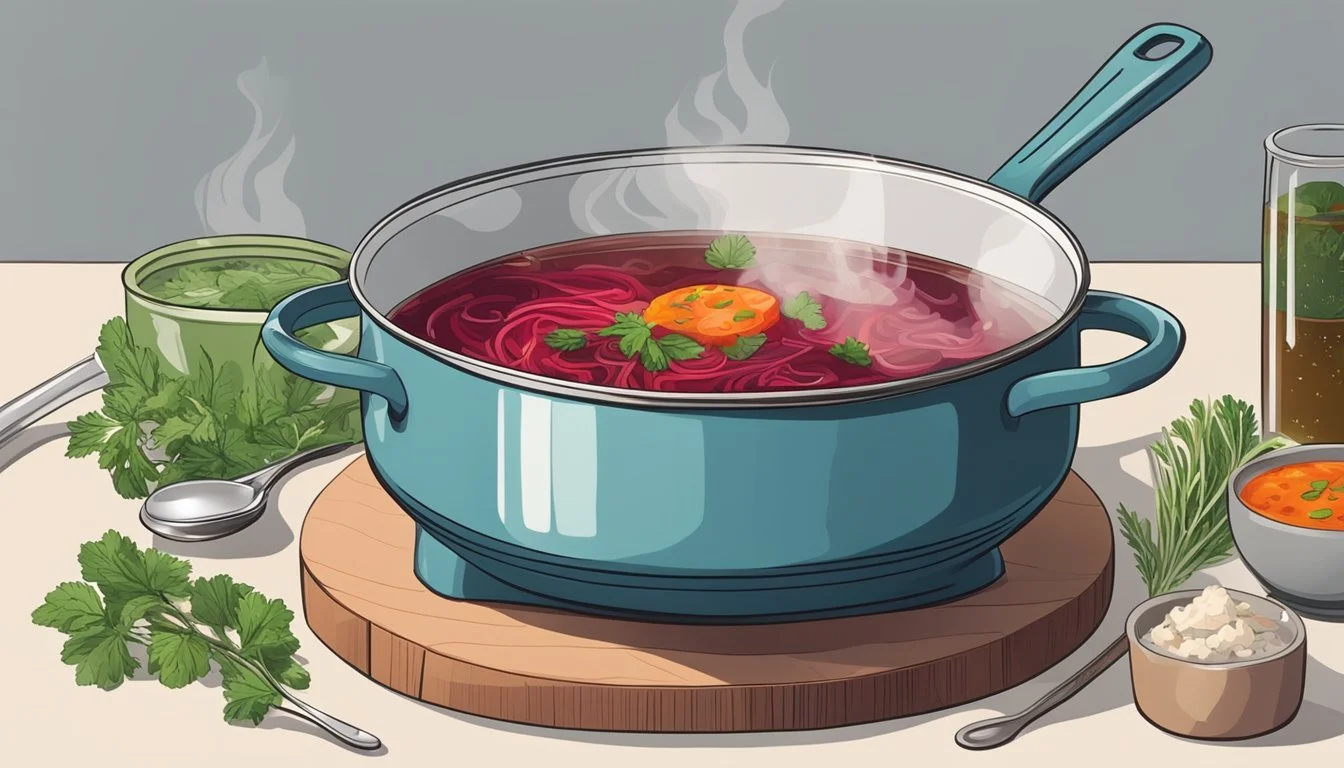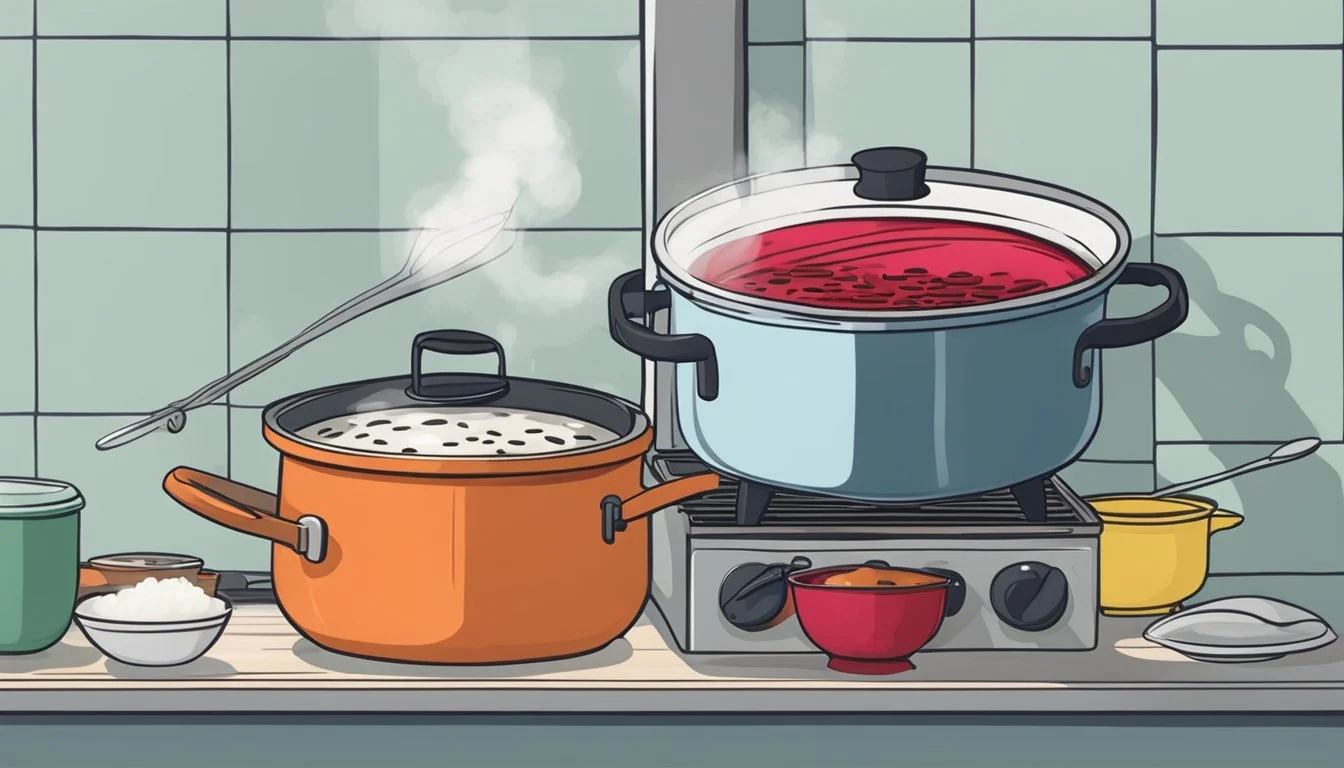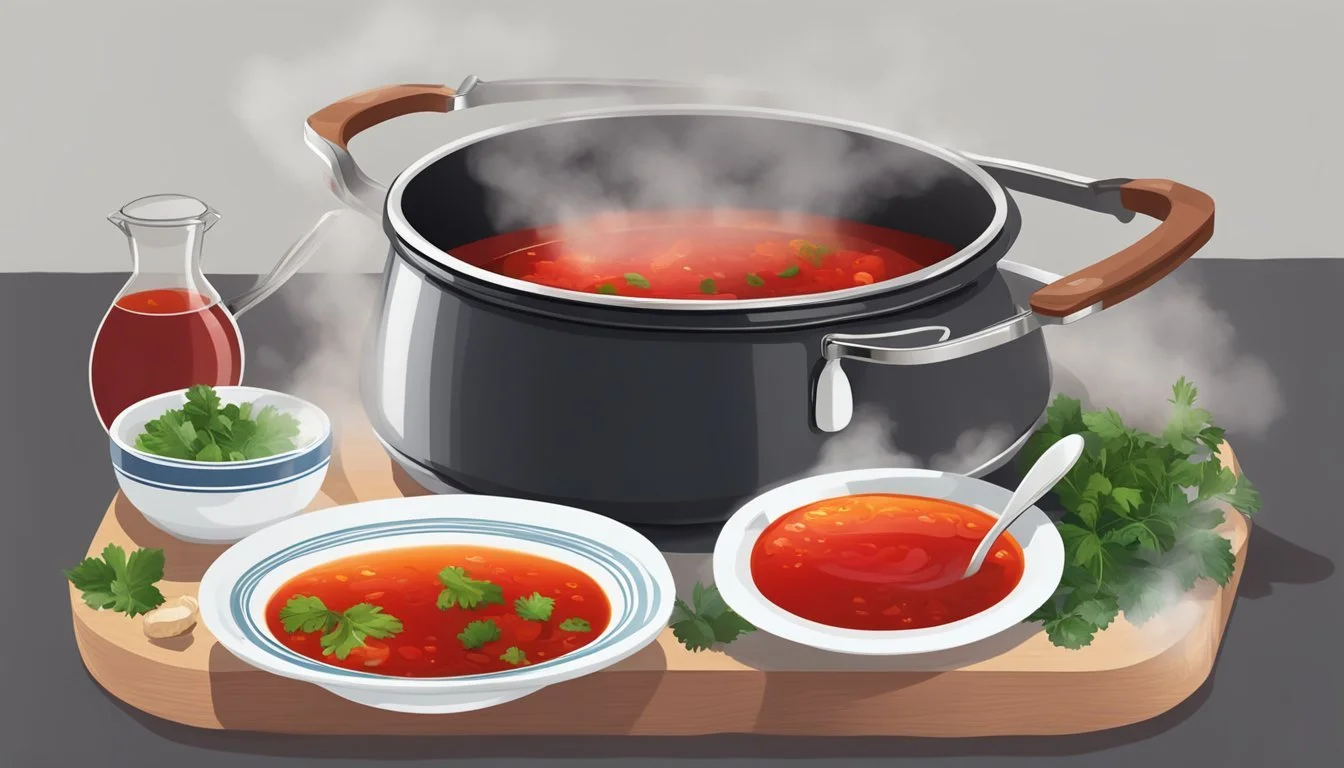How to Reheat Borscht
Simple and Effective Methods
Reheating borscht, the hearty and nutritious soup traditionally enjoyed in Ukraine and across Eastern Europe, might seem simple, but there's an art to preserving its robust flavors and vibrant colors. To reheat borscht perfectly, simmer it gently on low heat, allowing its rich blend of beets, cabbage, and other vegetables to warm through without breaking down. This method ensures that each spoonful retains the savory essence that makes this soup a beloved dish.
For those with a busy lifestyle, freezing and reheating borscht can be a practical option. Store the soup in airtight containers to maintain its freshness. When ready to enjoy, thaw the borscht in the refrigerator overnight and reheat it slowly on the stove to prevent losing its delicate flavors.
Whether you're enjoying a vegetarian version or a traditional recipe with beef, reheating borscht can enhance its flavors, making each meal a comforting experience. By following these simple reheating techniques, you can savor this Eastern European staple at its best, bringing a touch of tradition and coziness to your dining table.
Overview of Borscht
Borscht is a vibrant beet soup known for its deep red color and rich flavor. Originating in Eastern Europe, it holds cultural significance and comes in several variations depending on regional and personal preferences.
History and Significance
Borscht has deep roots in Eastern Europe, particularly in Ukraine and Russia. Historically, it was a staple dish among the rural population due to the availability of beets and other ingredients. It played an important role in peasant diet, providing nourishment throughout harsh winters.
Borscht is more than just food; it is a symbol of cultural identity. In Ukraine, borscht often incorporates beef or pork, while in Russia, it may be simpler, focusing on vegetables. The dish is often associated with family gatherings and holidays, emphasizing its cultural significance.
Cultural Variations
Traditional Ukrainian Borscht typically includes beets, cabbage, potatoes, and often meat like beef or pork. It is usually served hot with a dollop of sour cream and garnished with dill.
Russian Borscht, while similar, might be vegetarian or use meat sparingly. It can be lighter and often features a combination of beets, cabbage, and carrots.
Other variations include the Polish Barszcz, which can be either the clear broth version or with chunky vegetables, and the Lithuanian Cold Borscht, which is served chilled, especially during the summer.
These variations highlight the adaptability of borscht to different culinary traditions across Eastern Europe. Each version maintains the essential components of beets and cabbage while allowing for regional tastes and available ingredients.
Ingredients and Their Roles
Borscht is a flavorful, nutritious soup made with a variety of vegetables, herbs, and sometimes meat. Understanding the roles of each ingredient enhances the appreciation of this traditional dish.
Primary Ingredients
Beets
Beets are the heart of borscht, giving it a distinct color and earthy flavor. They are typically cooked until tender and then combined with other ingredients to create a rich base.
Cabbage
Cabbage adds texture and volume to the soup. It becomes soft while cooking, blending seamlessly with the other vegetables.
Carrots and Potatoes
Carrots and potatoes provide a subtle sweetness and body to the dish. They balance the flavors and add nutritional value.
Onion and Garlic
Onions and garlic are foundational, bringing depth and aroma. Fried onions add a savory note, while garlic enhances the overall flavor profile.
Tomato
Tomato juice or paste introduces acidity, which brightens the soup. It complements the sweetness of the beets and carrots.
Meat
Beef or chicken can be added to borscht, creating a heartier soup. The meat is typically cooked in the broth, infusing the soup with additional flavor.
Broth
A well-prepared beef or chicken broth forms the liquid base. It ties all the ingredients together, offering a full-bodied taste.
Herbs and Seasonings
Salt and Pepper
Salt and pepper are essential for seasoning, highlighting the natural flavors of the vegetables and meat. They should be adjusted to taste.
Dill
Fresh dill is a classic herb used in borscht. It adds a fresh, slightly citrusy note. Dill can be added towards the end of cooking to preserve its bright flavor.
Sour Cream
A dollop of sour cream is often served as a garnish. It adds creaminess and a tangy contrast to the rich, earthy soup.
Each ingredient in borscht serves a specific role, both in flavor and texture. Utilizing the right combination and balance ensures an authentic and enjoyable dish.
Health and Nutrition
Borscht is not only a delicious dish but also provides several nutritional benefits. It contains a variety of vitamins and minerals, along with being relatively low in calories, making it a healthy addition to any meal plan.
Nutritional Value
Borscht offers a rich supply of essential nutrients in each serving. A typical bowl may include a healthy mix of fiber, protein, vitamin C, iron, and potassium. The inclusion of beets and other vegetables enhances its nutritional profile.
Fiber: Beets, cabbage, and other veggies contribute to the fiber content, supporting digestive health.
Protein: When made with meat or legumes, borscht can provide a good source of protein.
Vitamin C: Beets and other vegetables help boost the immune system.
Iron: The vegetables and any added meats contribute to adequate iron intake.
Potassium: This mineral helps maintain proper heart and muscle functions.
On average, a serving of borscht is low in calories, making it suitable for those on a calorie-controlled diet. The fat content is generally low unless significant amounts of fatty meats are used, keeping saturated fat levels minimal.
Dietary Considerations
Borscht can be enjoyed by individuals following various diets due to its versatility.
Vegetarian or Vegan: Simply exclude meat and use vegetable broth. The soup still offers plenty of nutrients through the assortment of vegetables.
Low Sodium: Be mindful of the salt content as borscht can be high in sodium. Use low-sodium broth or reduce added salt to make it heart-healthier.
Low Fat: Using lean meats or skipping meat can significantly reduce fat and cholesterol levels.
Diabetic-Friendly: Borscht typically contains limited amounts of sugar despite the natural sugars in beets. However, portion control is advised for blood sugar management.
Gluten-Free: Borscht is naturally gluten-free if no wheat-based thickeners are added.
The potassium and other minerals also help in maintaining balanced nutrient intake, ensuring the meal is healthy for various dietary needs without compromising on taste.
Preparation Basics
Understanding the essential steps and cooking techniques for making borscht is crucial to achieving rich flavors and ideal consistency. This guide will walk you through the recipe steps and cooking methods to ensure your borscht comes out perfectly every time.
Borscht Recipe Steps
Prep Time: Approximately 20 minutes
Cook Time: Around 40 minutes
Ingredients Preparation:
Beets, carrots, and onions should be peeled and diced.
Potatoes cut into bite-sized pieces.
Cabbage shredded finely.
Initial Cooking:
Heat 1 tbsp of olive oil in a large pot over medium heat.
Add diced onions and cook until translucent.
Adding Vegetables:
Stir in beets and carrots, cooking for 5-7 minutes until softened.
Incorporate crushed tomatoes or tomato paste.
Simmering:
Add broth and bring to a boil.
Add potatoes, shredded cabbage, bay leaves, salt, and pepper.
Reduce to a simmer, cooking for about 15-20 minutes until all vegetables are tender.
Cooking Techniques
Stove Usage:
Heat Management: Start by searing beef (if using) on medium-high heat, then reduce to medium for vegetable cooking and simmering.
Simmering:
Maintaining a low, steady simmer ensures that flavors meld without overcooking.
Flavor Enhancements:
Adding bay leaves gives a subtle depth.
Finish with a splash of vinegar synthetic, enhancing the soup’s tanginess.
Adjust seasonings towards the end to perfect the taste.
Texture Considerations:
Ensure vegetables are cut uniformly for even cooking.
Softening the beets, carrots, and potatoes by cooking them in stages ensures each maintains its integrity while contributing to a thick, hearty consistency.
This structured approach ensures your borscht has a balanced, well-rounded flavor and a comforting texture.
Reheating Borscht
Reheating borscht requires attention to detail to preserve its rich flavors and ensure a satisfying meal. The methods discussed include using the stovetop and microwave, each tailored to achieve the best results.
Stovetop Method
Using the stovetop is ideal for reheating borscht, as it allows for even warming and careful control over the temperature. Begin by transferring the leftover borscht from an airtight container into a soup pot or saucepan.
Set the burner to medium heat.
Stir occasionally to prevent sticking and ensure uniform heating.
Gradually bring the borscht to a simmer, avoiding boiling to preserve the delicate flavors of the beets, cabbage, and other ingredients. If the borscht has thickened, add a splash of water or broth. Heat until warmed through, and serve immediately.
Microwave Technique
For a quicker option, the microwave can be used, though it's essential to follow certain steps to maintain quality. Place the borscht in a microwave-safe bowl. Cover the bowl with a microwave-safe lid or a paper towel to prevent splatters.
Heat on medium power.
Stir halfway through heating.
Typically, heating takes 3-5 minutes, depending on the microwave and portion size. Stirring at the midpoint ensures even warming. If the soup has thickened over time, adding a small amount of water or broth before microwaving can help in achieving the right consistency. Make sure the borscht is warmed thoroughly before serving.
Storing and Shelf Life
Proper storage is essential to maintain the freshness and flavor of borscht. Both short-term and long-term storage methods must be employed for optimal results.
Short-Term Storage
When planning to consume borscht within a few days, careful storage in the fridge is key. After cooking, let the borscht cool to room temperature before transferring it to an airtight container. This prevents any unwanted odors from the fridge from affecting the soup's flavor.
Borscht stored in this manner typically lasts 5 to 7 days in the fridge. Ensuring the container is well-sealed helps retain the vibrant flavors and freshness. For maximum quality, it's advised to reheat only the portion you plan to eat, reducing the risk of repeated temperature changes.
Long-Term Preservation
For longer storage, freezing borscht is an effective method. Once the soup has cooled to room temperature, portion it into freezer-safe airtight containers or heavy-duty freezer bags. Label and date the containers to keep track of storage times.
Frozen borscht remains at its best quality for 3 to 4 months. Although technically safe beyond this period, quality may diminish. Thaw the borscht in the fridge overnight before reheating and consuming to retain its texture and taste.
By following these guidelines, you can enjoy borscht at its freshest, whether you're planning for a few days or several months.
Serving Suggestions
Serving borscht with the right accompaniments and presentation makes the meal even more enjoyable, enhancing the experience with textures and complementary flavors.
Accompaniments
A dollop of sour cream is essential when serving borscht. It adds creaminess and balances the earthiness of the beets. Rye bread is a traditional choice; its dense texture pairs excellently with the rich soup. Fresh dill and parsley add an aromatic freshness that contrasts well with the other robust flavors.
Include whole garlic cloves and green onions dipped in coarse salt as garnish options. These can be served on the side for those who enjoy a bit of extra bite and flavor complexity.
Presentation Tips
Use deep bowls to serve borscht, ensuring enough room for the broth and hearty solids. Place a generous dollop of sour cream in the center and sprinkle with freshly chopped dill or parsley.
Arrange slices of rye bread on a small plate alongside the soup. For added visual appeal, lightly toast the bread and brush with a garlic-infused butter.
Serve with a small side dish of green onions and whole garlic cloves, letting diners add them as they please. This allows people to customize their borscht experience to their liking while maintaining an authentic presentation.
Customization and Variations
Reheating borscht offers many opportunities to tailor the dish to suit various dietary preferences and flavor profiles. Explore vegetarian and vegan options, along with alternative ingredients that can transform and elevate the dish.
Vegetarian and Vegan Options
Vegetarian and vegan borscht can be equally delicious and hearty as traditional versions. Green borscht, often made with sorrel, provides a slightly tangy flavor and can be prepared without meat or dairy.
To enhance the taste, replace meat broth with vegetable broth. Incorporate vegetables like green cabbage, carrots, and potatoes for added texture and flavor.
In vegan preparations, avoid dairy by replacing it with plant-based alternatives like coconut milk or almond milk. For added protein, beans can be a great addition. Red kidney beans or white beans make the borscht hearty and filling while keeping it vegan. Use a splash of vinegar or lemon juice to add the signature tang without animal products.
Alternative Ingredients
Experimenting with alternative ingredients can bring a refreshing twist to the borscht. Green cabbage can substitute for the more common red cabbage, providing a softer texture. White borscht, typically made with sour ingredients like fermented rye or wheat, offers a creamy alternative.
If you prefer a less earthy taste, replace traditional red beets with golden beets. They are milder and slightly sweeter.
Tomatoes can also be a fantastic addition, lending a bright acidity and rich color. Fresh or canned tomatoes blend seamlessly into the borscht base.
For a unique twist, consider adding bell peppers or zucchini for extra layers of flavor. Adjust the seasoning with herbs like dill or parsley to complement these alternative ingredients.
Special Tips and Tricks
Reheating borscht can be an art in itself, ensuring that its flavors remain bold and that the texture stays just as your grandmother made it. Here are some valuable tips to help you achieve a perfect reheated bowl of borscht.
Enhancing Flavor
To keep the flavor of reheated borscht as rich as possible, adding a bit of extra seasoning and fresh ingredients can make a significant difference.
Add Fresh Herbs: While reheating, consider adding fresh dill or parsley to brighten the flavor profile.
A Splash of Lemon: A small amount of lemon juice can help revive the tangy taste in the soup, ensuring it doesn't taste flat.
Include Garlic: Adding finely chopped or crushed garlic while reheating can enhance the savory notes and give an authentic touch.
Adjust Seasoning: Sometimes, flavors intensify in storage. Taste the borscht during reheating and adjust salt, pepper, or any other seasoning to maintain the perfect balance.
Use a Low Heat: Reheat on low to medium heat, ensuring that the soup warms evenly without losing its intricate flavors.
Texture Preservation
Maintaining the right texture is crucial. The goal is to keep the vegetables from becoming too mushy and the broth from losing its consistency.
Gentle Stirring: Frequently stir the borscht gently to evenly distribute the heat without breaking down the vegetables.
Slow Heating: Avoid using the microwave; instead, use a stovetop method. This is essential for preserving the soup's texture, as high heat can make the vegetables too soft.
Add Extra Liquid: If the borscht has thickened too much during storage, consider adding some broth or water while reheating.
Oil for Shine: A small drop of olive oil can help in maintaining a glossy and appealing soup once reheated.
Avoid Overcooking: As with the initial preparation, overcooking during reheating can ruin the texture. Once it's sufficiently warm, it's ready to serve.







